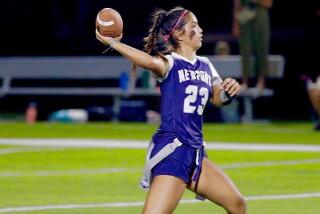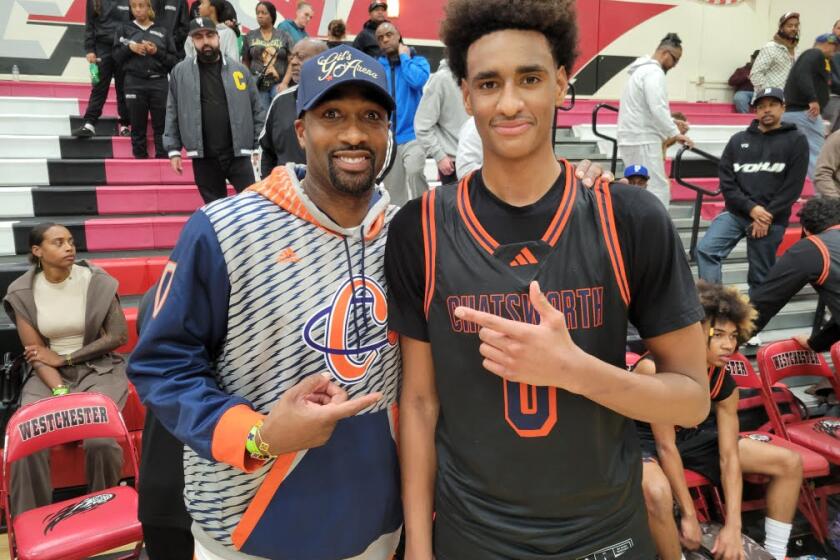Mixing of the Sexes Often Causes Mix-Ups of Minds : Girls vs. Boys a Battle of Myths, Fears
Alton Doyle, executive director of the New York State Public High School Athletic Assn., can’t understand why high school girls would want to play football.
He thinks they do it for the publicity. He says he’s afraid that a girl might suffer internal damage that could hamper reproductive functions years later. He says he worries that if more girls play on boys’ teams, existing girls’ programs will suffer.
Holly Turner, associate director of the Women’s Sports Foundation in San Francisco, thinks Doyle is worrying too much. She says that girls who go against the mainstream and play contact sports pose no threat to girls’ programs, and that they are no more susceptible to injury than boys.
Girls who have played on or are playing on boys’ teams maintain that they don’t do it for publicity. All they want to do is play.
It is an issue packed with a lot of myths, but not a lot of statistics. Most states responding to National Federation of State High School Associations participation surveys don’t signify participants’ gender.
The CIF Southern Section, like many other sections across the country, doesn’t keep statistics on how many girls are playing on boys’ teams.
It’s difficult to tell whether this is an increasing trend, or if there are any trends.
About the only certainty is that there seems to be a lack of understanding about the issue on some people’s part.
Doyle has been heavily involved with the issue. Last fall, Jacqueline Lantz got an injunction from a federal judge in New York City that allowed her to practice with the Lincoln High School team in Yonkers, N.Y.
There had been a rule in New York prohibiting mixed competition in football, basketball, boxing, ice hockey, rugby and wrestling, but the judge in the Lantz case said that if a girl was physically fit to play those sports, she should be allowed to do so.
Although Lantz wasn’t deemed fit to play junior varsity football and was dropped from the Lincoln team, the Board of Regents still amended an emergency measure to the previous rule, which states that girls, if they want to play in boys’ sports, must appear before a local review panel to determine whether they are physically fit.
The board will determine in February or March whether the emergency measure will become official. According to Doyle, there are presently three girls in New York who have applied, under the emergency measure, to wrestle and two girls playing on a boys’ varsity basketball team.
He thinks this is ridiculous.
“We have to take a long, hard professional look at a lot of these cases,” Doyle said. “Hopefully in time, this will all pass.”
Doyle, who coached football at New York’s Oxford Academy for 18 years, says he isn’t sure what motivates girls to play football and other contact sports. His opinion that it is for publicity stems from cases such as Beth Balsley’s.
Balsley, who played on the North Hunterton High football team in Clinton, N.J. last fall, was the subject of New York Times, New York Daily News and Time magazine articles, and she also appeared on the Phil Donahue Show.
Doyle thinks that more girls will try out for football next fall, and that as more girls play on boys’ teams, the girls’ sports programs will suffer. Turner disagrees.
“There are not so many girls who want to wrestle or play football that the girls’ basketball programs are in jeopardy,” she said. “I think the numbers are relatively small right now.
“Looking into the future, I suppose there’s a possibility that girls may spread their interests among a larger number of sports, but I don’t see that as being so terribly detrimental. If lots of girls express interest in (contact) sports, their own programs will evolve out of those interests.”
As for the injury factor, a girl who is smaller, lighter and has less bone density than a boy may be more susceptible to injury, according to Dr. David Webb, of the Center for Sports Medicine at San Francisco’s St. Francis Hospital.
“But it’s more a size, maturity and strength difference than a sex difference,” Webb said. “Given comparable weight and muscle, a girl’s risk to injury is about the same as a boy’s. I also don’t know that collision poses a definite risk to female internal organs.”
Webb noted that the frequent football injuries--to the knee ligaments and ankles--are often caused by poor technique. Sometimes, it’s not a question of strength or speed. It’s a matter of making a mistake at the wrong time. That can happen to a boy or a girl, he said.
So, what may increase a girl’s risk to injury is the fact that she may not be as experienced in football as the boys who are playing.
“A boy who has played football since the third grade knows how to tackle and how to block by the time he’s in high school,” Webb said. “A girl playing for the first time will be naive in that area. It’s important for girls starting out to get good coaching and to learn the techniques.
“It is factors such as these, rather than the sex difference, that might place girls at a higher risk to injury.”
Although Turner advocates the participation of girls in contact sports if they are interested in and capable of playing, and if there is not a program for them to play with girls, she concedes that it’s not always in the best interest of girls to play on the boys’ teams.
“It isn’t always appropriate because girls, historically, have not developed athletic skills to the extent that boys have,” she said. “The way boys have been socialized gives them the advantage. Boys have been throwing the ball in the backyard since their early years, and their natural skill is usually better than the girls’ at all ages.”
But that hasn’t stopped girls such as Balsley, who appeared briefly as a nose guard during one of North Hunterton High’s junior varsity games last fall; Bridget Farris, who kicked four extra points for the Fresno Hoover High varsity team; Lizzie Luna, who played on the Westchester (Los Angeles) freshman football team; America Morris, who earned a position on the Clairemont (San Diego) High varsity wrestling team and recently pinned an opponent; or Kari Walrich and Cindy Robert, who are playing on the boys’ varsity basketball team at Colton-Pierrpont High in Colton, N.Y.
What some administrators, such as Doyle, can’t understand is why girls would want to play on a boys’ team when there are usually a sufficient number of other sports and facilities available for girls in high school.
They argue that girls’ programs have improved tremendously since the 1972 passing of Title IX, which went into effect in 1975. The legislation states that “no person shall, on the basis of sex, be excluded from participation in, be denied the benefits of, or be subjected to discrimination under any education program or activity receiving federal financial assistance.”
Don Sabo, associate professor of social sciences at D’Youville College in Buffalo, who has conducted several surveys on the attitudes of girls and women in athletics, offers this explanation:
“My sense of it is that we live in an age when the history of the last few decades has been that women have been acting and men have been reacting. Women are moving into what were considered to be traditionally thought-of male occupations, male sanctuaries, and sports is one of those.
“I see a move toward co-ed sports as another mountain to climb for women who are assertive, innovative and gutsy. It’s a way for them to test themselves and to develop social and athletic skills.”
A closer look at individual cases dispels Doyle’s notion that girls play on boys’ teams for the publicity.
At Colton-Pierrpont High, a school with 80 students in upstate New York, there weren’t enough junior or senior girls to field a competitive varsity basketball team, so the administration decided to drop the varsity team and keep two lower-level teams.
That left Kari Walrich, a junior who had started on the varsity since her freshman year and was the team’s leading scorer last season, and Cindy Robert, a senior who was a returning varsity starter, out.
Neither wanted to play junior varsity basketball, so they tried out for the boys’ team--and made it. They have been eligible for three of the Colts’ games and have played sparingly in two of them. Robert made a free throw on Dec. 19 against Salmon River High and is believed to be the first girl to score in a boys’ varsity game in New York.
“A lot of people think we went out for the publicity, but that’s totally opposite from the reasons we’re playing,” Walrich said. “We wanted to keep active in sports and stay in shape for other sports. Mainly, I love the game of basketball and don’t think I could go without it for a year. I wish people would understand that.”
Both girls said they would rather be playing on a girls’ team, where they would see a lot more action, and Walrich said she will return to the girls’ team next year if the school has one. But she believes playing a season on the boys’ team will be a good experience.
“It has improved my skills a great deal,” she said. “Practices are tougher and playing with the guys makes me a better player. I’ll definitely be stronger because of this.”
Ronald Gotham, coach at Colton-Pierrpont, doesn’t mind coaching the girls.
“They’re top-notch athletes in all the sports they play (soccer, volleyball, basketball and softball),” he said. “They really have a good idea of what it takes to be a good athlete, and they’re a positive influence on the team. They’re very excited to be participating.
“The girls have had some shots blocked and have been knocked around, but they don’t let that bother them. The guys help them up just as they would any other player. And as far as stamina goes, they cut it very well in practice.”
Bridget Farris, who is believed to be the first girl to score in a varsity football game in California, was an outstanding soccer player who read a book on football kicking technique and practiced diligently before last season.
It didn’t matter that Farris was a girl--she was still good enough to earn the kicking position (for extra points) on her varsity team.
America Morris earned her position on the Clairemont High wrestling team by pinning a a teammate in a challenge match. Her pin in the 107-pound division of the recent Bob Roeder Wrestling Invitational was believed to be the first by a girl in California wrestling history.
“I think me winning that match made a statement,” said Morris, who was quoted in an Associated Press story. “I didn’t make the varsity team just to mess around. I proved a lot of people wrong. I wish they’d open their minds and close their mouths.”
George Greiner, the coach at North Hunterton High in New Jersey, wasn’t particularly happy with the attention given to Balsley, easily the most publicized girl to play football last fall.
“She has no athletic ability whatsoever,” Greiner said. “She could work until the cows came home, but she would never be able to play our level of football.”
But Turner, who appeared on the Phil Donahue Show with Balsley, praised her for her determination to remain on the team, though she only played in one junior varsity game.
“She just wanted the fun of competition,” Turner said. “Her skill level will weed her out, but I support Beth 100% for doing what she wants to do. She’s no different than any other boy on that team who wasn’t good enough to play.”
More to Read
Get our high school sports newsletter
Prep Rally is devoted to the SoCal high school sports experience, bringing you scores, stories and a behind-the-scenes look at what makes prep sports so popular.
You may occasionally receive promotional content from the Los Angeles Times.







